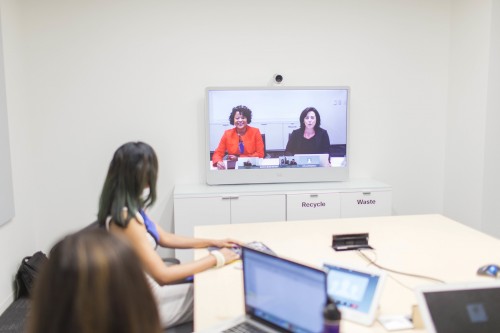
First impressions count: how start-ups can make an impact in that first important meeting
You’re not supposed to judge a book by its cover, but you’d probably be lying if you said you’d never broken this commandment before.
From the strength of your handshake, to the shine of your shoes and the ‘is that a bead of sweat on my forehead’ anxieties, first meetings can be a vessel for irrational insecurities.
And yet in the world of start-ups, where putting faces to names is invaluable, first impressions can be some of the most important ones you make.
To (shamelessly) employ another cliché, you never get a second chance to make a first impression.
So we got in touch with communications coach Jon Torrens who, with more than 400 stand-up comedy appearances to his name, knows a thing or two about impressing a room full of strangers…
—

Want to blow them away with your pitch? Your start is crucial. Follow these tips to make them sit up and take notice:
Reconnaissance, equipment and strategy
Check out the venue beforehand if possible. Familiarise yourself with the layout, and – very important, this – the tech. Doing a test run with all the hardware could save several awkward minutes of floundering with the TV’s aspect ratio and confusing input select options. Test your clicker and make sure it’s ready to go.
Run through the first few minutes of your pitch and you’ll feel way more relaxed and in control when you’re delivering it for real. Go you.
Have multiple backup plans. Unexpected things will happen. Be ready for them:
- Bring PDFs in case the resident PC substitutes your brilliant font with a default one (embed fonts when saving if possible)
- Bring cues (printed A4 sheets or cue cards)
- Print out all your materials
- Be ready to draw/act things out if necessary
 Being prepared in this way will not only save your neck by keeping things moving, it’ll make you look like a creative
Being prepared in this way will not only save your neck by keeping things moving, it’ll make you look like a creative
problem-solver who can handle anything and who doesn’t waste time. Which is precisely what they’re after.
Rehearse. Run through the whole thing at full pace and volume at least three times – if one of these is in the venue itself then that’s ideal. More rehearsal is better, but re-word it slightly each time or the repeated syntax will become a bit wooden. This will smooth out your delivery (by keeping it conversational) as well as boosting your confidence. Plus you’ll get the timing more consistent, and coming in on – or under – time will be a rare (but very welcome) surprise for the people you’re pitching to.
Calm. Down.
You’re nervous because:
- You don’t know what’s going to happen
- You care about the result
This combination is completely normal. Every speaker feels nervous beforehand, it’s just that some are better at hiding it than others.
You won’t get rid of your nerves, but you don’t have to. They’re an irrational survival instinct (your subconscious only knows the threat of physical danger). All you need to do is counter them with confidence achieved through correct preparation. On the day itself you can reassure yourself with the fact that you’re ready. Some people will be nervous because they haven’t prepared sufficiently – and there’s not much they can do about that.
Breathe slowly. When you get nervous, your heart rate increases. To slow it down and calm your mental state, concentrate on slowing your breathing down and wait for your ticker to follow suit.
Visualise success. You can re-program your subconscious by imagining yourself having a great time. Your subconscious doesn’t know the difference between real and imagined events and you can easily fool it with this technique. It may sound like psychobabble but it really works.
Your physical stance can alter your mental state in a very positive way. Learn how by watching Amy Cuddy’s TED talk on power poses.
Be present
Time to deliver. You’re in a great place because you’ve prepared correctly and your mind is relatively calm, despite the pressure (you hero). Walk out there and do the following:
- Make eye contact
- Smile (a lot of people forget to do this and put on their ‘professional’ game face instead)
- Introduce yourself and your subject
This combination will convince most audiences that you know what you’re doing, and therefore are worth listening to. Here are a few possible issues:
What the hell do I do with my hands? You can gesticulate, which is natural and can be very expressive. You can also hold your cue cards or clicker. For goodness sake don’t fold your arms or put your hands in your pockets.
Am I talking too fast? Along with your heart rate and thought processes, your speaking cadence has probably doubled. People rarely talk too slowly. Slow down and try throwing in some pauses – they’ll lend what you’ve just said some gravitas while also giving the audience time to digest (and yourself a moment to consider your next section).
Unexpected event! Tech fail? Drilling started next door? Don’t hope it’ll just go away. Be in the moment, state clearly what’s happened and you may even get a laugh from the punctured tension. I find that smiling and saying “Well, I didn’t anticipate that happening” allows me to maintain control and create a connection with the audience. Then use one of your multiple backup plans if necessary. Remember those?
And finally: remember that your audience wants you to do well.
—
Jon Torrens is a communications coach and speaker. He previously worked as a designer at games companies including Sony and Electronic Arts, and as a professional stand-up comic for a few years. Insights from these two worlds now allow him to help even the most introverted of his clients to deliver presentations that enhance their professional persona and both delight and motivate their audiences. He has delivered communication skills training for Cambridge University and for a variety of tech companies and software developers in Cambridge and London. For more communication confidence tips, you can pay Jon’s website a visit and follow him on Twitter at @JonTorrens.
###
Do you know someone who would benefit from this content? Feel free to share with your social networks and help us spread the word.
If there’s a topic area you’d like us to cover in more detail, or if you have a question you’d like to ask, please let us know in the comments below or drop us a line at startupsupport@external.cisco.com.
Tags:



